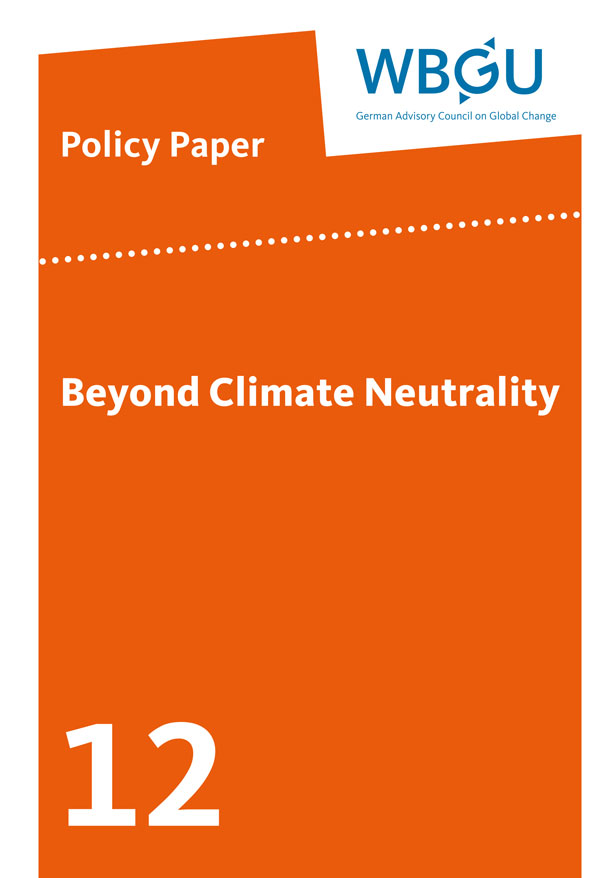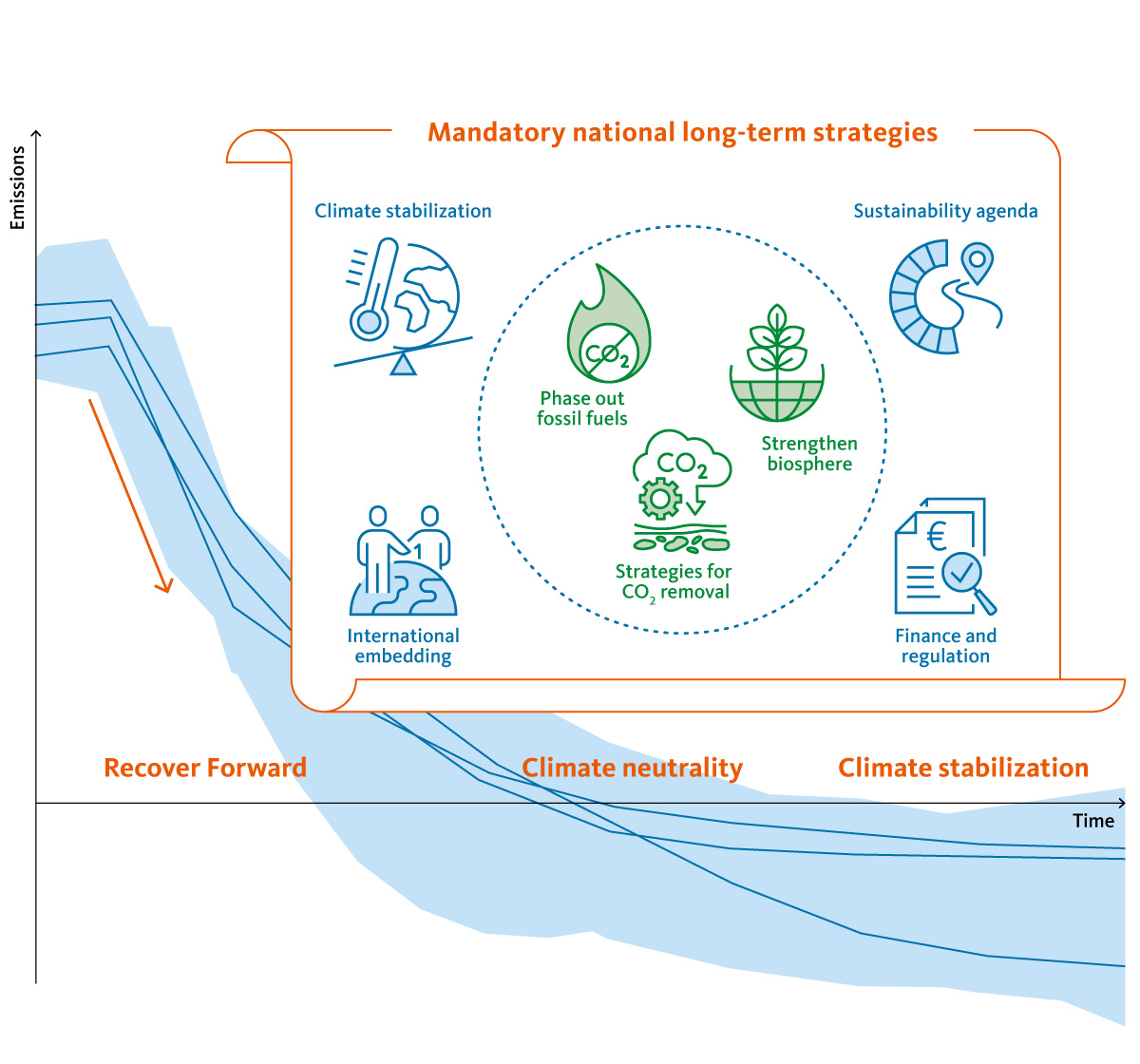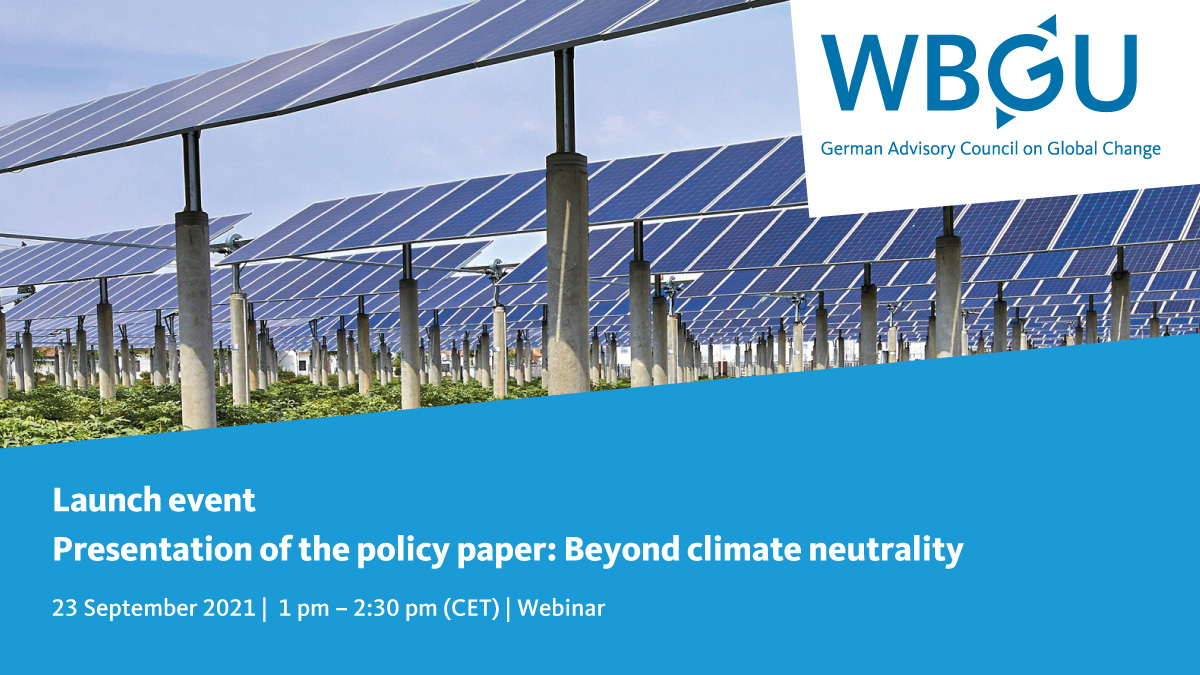
Beyond Climate Neutrality

The climate crisis and the crises caused by the COVID-19 pandemic must be tackled together. Many countries are working on strategies to implement the Paris Agreement. At the climate conference in Glasgow, therefore, it will be imperative to reconcile short- and long-term goals and measures.
Overview
German legislators have been obliged by the Federal Constitutional Court to plan climate-change mitigation for the long term. It should also be made mandatory at the international level to formulate and communicate long-term strategies which aim beyond climate neutrality at climate stabilization and strive for multiple benefits with other sustainability dimensions. To this end they should first contain a rapid and complete phase-out of fossil-fuel use. Second, the conservation, restoration and sustainable use of ecosystems should become a priority. Third, strategic preparations should be made for the removal of CO2 from the atmosphere. To generate a strong momentum, countries at COP 26 should commit to using their COVID-19 stimulus programmes in line with long-term strategies.
More about this topic
In the Paris Agreement, countries agreed not only on the long-term goal of climate stabilization, but also on making their financial flows consistent with the aims of climate-change mitigation and adaptation. Specific decisions on both aspects should be taken at COP 26 in Glasgow: countries should use long-term strategies to orient their short- and long-term goals and measures towards climate stabilization and use the COVID-19 stimulus programmes to transform their economies in the direction of climate action.
Climate stabilization as a long-term goal of international climate policy
Climate stabilization means the permanent limitation of global warming, preferably to 1.5°C above pre-industrial levels in order to prevent dangerous anthropogenic interference with the climate system. This requires more than ‘climate neutrality’ – currently the stated goal of many countries. Regardless of its exact definition, climate neutrality can only be an intermediate goal. First, anthropogenic CO2 emissions must be stopped very quickly; non-CO2 emissions must be greatly reduced and the biosphere strengthened at the same time. Second, beyond climate neutrality, CO2 will probably need to be removed from the atmosphere to counteract high past emissions and remaining trends towards warming. This should be anticipated by technological development paths to make this option possible.
Make mandatory long-term strategies a major topic at COP 26
Long-term strategies within the framework of the Paris Agreement can become the basis for an international discussion on transformation pathways. Their formulation, communication and periodic review should be made compulsory. Countries should commit to orienting their long-term strategies towards climate stabilization and to using their COVID-19 stimulus programmes to achieve this. Minimum requirements should be defined for coherent, effective and fair long-term strategies, as well as for ensuring their measurability and comparability.
Long-term strategies provide a framework for the further development of short-term Nationally Determined Contributions (NDCs). They should incorporate the sustainability agenda and generate multiple benefits. It will also be easier to meet climate-protection goals if the world as a whole is on a more sustainable development path.
Any long-term strategy should primarily exploit national potential for climate-change mitigation. International effects should be taken into account and developing countries, especially low-income countries, supported on a partnership basis (e.g. in building and expanding value chains, social security and environmental monitoring). National expenditure on sustainability-oriented, transformative research, development and education should also be significantly increased in developing countries and emerging economies, not least to create a broad knowledge base for a common discourse. Long-term strategies should provide guidance for reliable regulatory frameworks and financing mechanisms. A clear distinction should be made between public and private financing contributions; the envisaged role of international financing mechanisms and collaborations should be made transparent, and public funds should be pledged for longer terms.
Set priorities for long-term strategies: stop, strengthen, think ahead
Long-term strategies should set three substantive priorities for climate-change mitigation that are not mutually substitutable:
- Stop CO2 emissions from fossil sources: The WBGU recommends rapidly and completely phasing out the combustion of fossil fuels and limiting their material use to cases where no sustainable alternatives can be developed. Ending the exploration, extraction and processing of fossil resources also reduces CH4 emissions, has considerable additional benefits for health and biodiversity, and should be negotiated multilaterally. Measures that support the phase-out (e.g. CO2 prices, subsidy reductions and infrastructure measures) should be outlined and future energy needs estimated. The interim targets and the point in time when no more CO2 is released from fossil sources should be based on an appropriate share of the remaining global emissions budget.
- Strengthen the contribution of the biosphere: The protection, restoration and sustainable use of ecosystems on land and in the ocean should link biodiversity conservation with climate-change mitigation. The sink effect of ecosystems has already been degraded and biodiversity conservation is at risk; both can only be secured in the long term if emissions are ambitiously reduced. The diversification of farming systems (with lower CH4 and N2O emissions), the transformation of animal-product-heavy diets, and a responsible bioeconomy can contribute to both goals. Financial incentives, taxes and reporting requirements for companies should be geared towards strengthening ecosystem services, and long-distance ecological effects (telecoupling) should be better researched and addressed.
- Planning ahead for the removal of CO2 from the atmosphere: In order to maintain the prospects for climate stabilization even if CO2-emission reductions are insufficient, options for permanent CO2 removal (e.g. BECCS, DACCS, biochar) should be kept open. Technologies in which CO2 extracted at great effort from the atmosphere is re-released within a short time (e.g. synthetic fuels) compete with long-term carbon storage and should therefore only be pursued in the absence of sustainable alternatives. Furthermore, negative impacts on other sustainability goals, e.g. caused by high biomass or land-use requirements, should be prevented. A portfolio approach could mitigate scaling-related sustainability problems of individual CO2-removal technologies. Incentives for using technical options should only be created when there is a governance framework that ensures sustainability. However, relying on the future recovery of emitted CO2 using technologies that are still under-researched is very risky.
All three priorities are necessary, although phasing out fossil fuels and strengthening the biosphere are fundamental. Each should have their own goals, intermediate targets and measures, and be tracked with indicators, without offsetting fossil-emission reductions, ecosystem services and CO2 removal against each other. At the same time, interactions between the solution approaches must be taken into account to make a comprehensive transformation possible. The impacts of planned technology and transformation pathways on all dimensions of the 2030 Agenda should be assessed.
Recover Forward: using COVID-19 stimuli for climate stabilization
In response to the COVID-19 pandemic, US$16 trillion had been mobilized globally up to March 2021, representing both an opportunity and a risk for long-term climate stabilization. Around 30% of the stimulus programmes relate to environmentally sensitive sectors, but do not take sustainability concerns sufficiently into account (e.g. a negative overall effect on the environment is expected in 15 of the G20 countries). Moreover, people in South Asia and sub-Saharan Africa in particular are additionally threatened by extreme poverty as a result of the COVID-19 crisis, yet per-capita stimulus spending is about 580 times higher in high-income countries than in low-income countries. The differences in national economic capabilities thus threaten to become more entrenched and could make it more difficult to jointly tackle global challenges such as climate change, the biodiversity crisis or pandemics. The COVID-19 stimulus programmes and climate-policy framework measures should – like all forms of government support and investment – be more closely aligned with long-term strategies and be used for an ecologically and socially compatible, globally balanced transformation of economic and societal systems.

More on the Subject
PDF and eBook Download
Deutsch
- Download: Über Klimaneutralität hinausdenken (PDF, navigierbar, 2 MB)
- Download: Über Klimaneutralität hinausdenken (eBook, epub, 1 MB)
Englisch
- Download: Beyond Climate Neutrality (PDF navigable 2 MB)
- Download: Beyond Climate Neutrality (eBook epub 3 MB)

